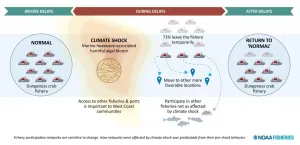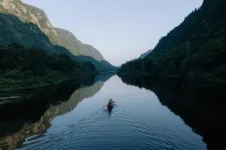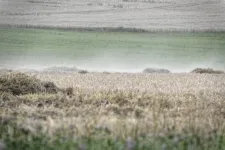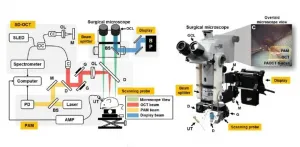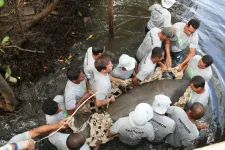(Press-News.org) Fishermen contend with regulations, natural disasters, and the ups and downs of the stocks they fish, along with many other changes. As a result, fishing communities are quite resilient. That is, they can withstand, recover from, and adapt to change.
But how much pressure can they stand? The 2014-2016 North Pacific marine heatwave, known as the Blob, led to a harmful algal bloom of unprecedented scale. It necessitated substantial delays in the opening of the 2015-16 U.S. West Coast Dungeness crab fishery. The fishery is vital to West Coast communities. It produces around 26 percent of all annual fishing revenue and supports more than 30 percent of all commercial fishing vessels.
Understanding Impacts from Climate Shocks
Previous studies have documented the devastating economic impacts from the 2015-16 event on Dungeness crab fishermen. Members of affected coastal communities attest that these socioeconomic effects rippled through associated industries and coastal communities. But can changes in fishing practices in response to this significant climate shock be quantified?
"We wanted to examine the extent to which the Dungeness crab fishery delays affected participation in other fisheries, and the duration of those changes," said Mary Fisher, a doctoral student at the University of Washington. Fisher did the work as a National Science Foundation Graduate Research Internship Program Fellow at NOAA's Northwest Fisheries Science Center.
Fisher and her colleagues at NOAA Fisheries, University of Washington, and Oregon State University studied the impacts on more than 2,500 vessels across seven California fishing communities. The researchers wanted to see how a climate-related shock (like the heatwave and associated harmful algal bloom) can impact communities' use of ocean resources.
The researchers used 10 years of fishery landings data to map resource use networks for seven California port groups where Dungeness crab is an important revenue source. The networks visualize the portfolio of fisheries that a community harvests and how vessels move between fisheries. The network visualization is similar to a food web, except that the connections represent harvest by fishing vessels rather than predator-prey relationships.
Resilient Fishing Communities
Researchers found that 71 percent of California Dungeness crab fishing vessels temporarily left the industry and stopped fishing altogether during the delays. The two other strategies that fishermen used to cope with the disruption were:
Participating in other fisheries that were not affected by the harmful algal bloom.
Moving out of delayed areas to fish in other more favorable locations.
These strategies significantly changed communities' resource use patterns, but some communities were more affected by the climate shock than others. Researchers could predict which communities would be least sensitive to the shock by looking at their resource use patterns before the 2015-16 season.
These communities, located in central California, were less dependent on Dungeness crab and had shorter fishery delays. In these communities, fishermen had access to more open fisheries during the winter months and were more flexible in how they fished previously. These characteristics provided more options, buffering fishermen from the disruption to the Dungeness crab fishing season.
No matter how central Dungeness crab was to a community's fisheries portfolio, the researchers didn't observe any significant, lasting changes in how vessels participated in fisheries after the closures lifted. This suggests fishing communities may mostly return to "normal" fishing practices relatively quickly after short-term disturbances like climate shocks, provided those changes don't pile up one after the other.
Access to Other Fisheries and Ports Important
The results highlight the importance of nearshore groundfish fisheries like sablefish, rockfish, and lingcod as alternatives to the Dungeness crab fishery. "Most of the crab vessels that stayed out on the water were using pot or hook-and-line gear to fish groundfish," says Fisher. "I think we can expect access to these fisheries to continue to be important during crab season delays."
Fishermen with larger vessels also landed their catch at different ports, a strategy less common among smaller vessels. This was possible in part because regulations only restricted fishing in delayed areas at the district level. In 2018, the California Department of Fish and Wildlife amended these rules, called the Fair Start Provisions. The amendments provide more protection to fishermen at a finer scale than districts in the event of future delays.
INFORMATION:
Humans have consumed different types of fermented foods - from kimchi to yogurt - for thousands of years. Yet only recently, with the availability of new scientific techniques for analyzing their nutritional properties and microbiological composition, have scientists begun to understand exactly how the unique flavors and textures are created and how these foods benefit human health.
Now, 13 interdisciplinary scientists from the fields of microbiology, food science and technology, family medicine, ecology, immunology, and microbial genetics have come together to create the first international consensus definition of fermented ...
Hotel managers have something in common beyond their reputations for charming dispositions and excellent listening skills - they're predominantly men, despite women making up the majority of the accommodations workforce. New research led by the University of Houston Conrad N. Hilton College of Hotel and Restaurant Management suggests hotel companies that promote a woman over an equally qualified man are perceived as fairer and less discriminatory, creating a stronger organizational culture and higher financial performance.
Published in the International Journal of Contemporary Hospitality Management, the study is the first to address gender inequity in promotional opportunities for hotel employees. The researchers surveyed 87 hotel ...
DENVER/January 5, 2020 - Some English bulldogs diagnosed with a common cancer may instead have a newly described, non-cancerous syndrome called polyclonal B‐cell lymphocytosis. The discovery was made by Morris Animal Foundation-funded researchers at Colorado State University during a study to better understand B-cell chronic lymphocytic leukemia (BCLL). The team published their findings in the Journal of Veterinary Internal Medicine.
"This could save some dogs from being misdiagnosed, treated for cancer or even euthanized when they shouldn't be," said Dr. Anne Avery, Professor, Department of Microbiology, Immunology and Pathology at Colorado State University. "The dogs may look to their veterinarians like they ...
BOSTON - (January 4, 2021) - As they age, people with diabetes are more likely to develop Alzheimer's disease and other cognitive disorders than are people without diabetes. Scientists at Joslin Diabetes Center now have shown that routine eye imaging can identify changes in the retina that may be associated with cognitive disorders in older people with type 1 diabetes.
These results may open up a relatively easy method for early detection of cognitive decline in this population, providing better ways to understand, diagnose and ultimately treat the decline, said George L. King, MD, Joslin's Chief Scientific Officer and senior author on a paper about the study in the Journal of Clinical Endocrinology & Metabolism.
Previous research had demonstrated an association ...
To stop biodiversity loss, Canada recently committed to protecting 30% of its land and sea by 2030. But making conservation decisions about where to locate new protected areas is complicated. It depends on data both about biodiversity and about a range of benefits (e.g. freshwater, climate regulation, recreation) that people get from nature. Surprisingly, despite the size of the country, new mapping suggests that less than 1% of Canada's land (0.6% of total area or approximately 56,000 km2) is a hot spot, providing all these benefits in one place. Moreover, the study published today in Environmental Research Letters suggests that some of the most critical areas where people receive these key benefits from ...
Leipzig. The transition from the Medieval Warm Period to the Little Ice Age was apparently accompanied by severe droughts between 1302 and 1307 in Europe; this preceded the wet and cold phase of the 1310s and the resulting great famine of 1315-21. In the journal Climate of the Past, researchers from the Leibniz Institutes for the History and Culture of Eastern Europe (GWZO) and Tropospheric Research (TROPOS) write that the 1302-07 weather patterns display similarities to the 2018 weather anomaly, in which continental Europe experienced exceptional heat and drought. Both the medieval and recent weather patterns resemble the stable weather patterns that have occurred more frequently since the 1980s due to the increased warming of the Arctic. ...
A clear view of anatomical structures is vital for the success of surgery--especially in microsurgery where narrow anatomical cavities or proximity to vulnerable organs and tissues can pose significant risks to patient health. The surgical microscope has evolved to become a powerful tool for improving surgical visualization.
A END ...
TROY, N.Y. -- A loss of enzymatic processes within the body can increase a person's risk of bone fracture. This new insight was recently published in eLife by an international team of scientists and engineers led by Deepak Vashishth, the director of the Center for Biotechnology and Interdisciplinary Studies (CBIS) at Rensselaer Polytechnic Institute.
Enzymatic processes are essential to any number of chemical reactions that occur within the body, including the production of the extracellular matrix within bone that is critical for mechanical support. Phosphorylation -- one of those key enzymatic processes -- is the attachment of a phosphoryl to a protein, and is critical for ...
Worldwide, marine megafauna are at risk of extinction due to climate change, habitat loss, pollution, overhunting, population fragmentation, and hybridization with related species in areas disturbed by humans. Genetic studies can help determine the conservation status of marine animals, identifying threats to species conservation and informing interventions and policies, such as the protection of diversity hotspots or corridors for gene flow.
In a new study in Frontiers in Marine Science, researchers for the first time measured genetic diversity in manatees ...
CHAMPAIGN, Ill. -- A small portion of scientific papers are retracted for research that is in error or fraudulent. But those papers can continue to be cited by other scientists in their work, potentially passing along the misinformation from the retracted articles.
Jodi Schneider, a professor of information sciences at the University of Illinois Urbana-Champaign who studies scholarly publications and how information gets used, is considering how scientific journals can better communicate about retracted articles. In a new study published in the ...
